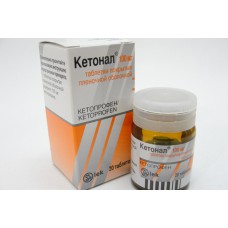Expiration date: 01/2026
The composition and form of issue:
Solution for intravenous and intramuscular administration of 1 ml
active substance:
Ketoprofen 50 mg
excipients: propylene glycol, ethanol, benzyl alcohol sodium hydroxide water for injections
in sealed dark glass to 2 ml in blistere 5 or 10 PCs per cartons 2, or 5 blisters of 5 ampoules or 5 blisters of 10 vials
Capsules 1 caps.
active substance:
Ketoprofen 50 mg
excipients: lactose magnesium stearate silicon dioxide colloidal
capsule shell: gelatin titanium dioxide patent blue dye "Patent blue V"
in bottles of dark glass 25 PCs in a pack of cardboard 1 FL.
Tablets, film-coated 1 tab.
active substance:
Ketoprofen 100 mg
excipients: magnesium stearate silica colloidal anhydrous povidone corn starch talc lactose
shell: hypromellose macrogol 400 Indigo Carmine (E132) titanium dioxide talc beeswax Carnauba
in bottles of dark glass 20 PCs. in a pack of cardboard 1 FL.
Extended-release tablets, 1 tab.
active substance :
Ketoprofen 150 mg
excipients: magnesium stearate silica colloidal anhydrous hypromellose povidone MCC
in bottles of dark glass 20 PCs. in a pack of cardboard 1 FL.
Description of dosage form:
Solution for intravenous and intramuscular injection: clear, colorless or slightly yellowish.
Capsules: opaque, ? 3, white body, blue cover.
The contents of capsules-crumbly or powder sprayed white with a yellowish tinge.
Film-coated tablets: light blue, round, biconvex.
Extended-release tablets: white, round, lenticular.
Pharmacokinetics:
Solution for intravenous and intramuscular administration. Bioavailability - more than 90%. Binding to plasma proteins-99%. The maximum concentration of the drug in plasma is achieved by parenteral administration after 15-30 min. Ketoprofen penetrates the synovial fluid.
Ketoprofen undergoes extensive metabolism through the microsomal enzymes of the liver. It binds to glucuronic acid and is excreted as glucuronide. Up to 80% of Ketoprofen is excreted by the kidneys, mainly (more than 90%) in the form of Ketoprofen glucuronide and approximately 10% — through the intestine. Due to the rapid metabolism of Ketoprofen, its biological T1 / 2 is less than 2 hours.
Capsules, film-coated tablets, 100 mg, prolonged-action tablets 150 mg Ketoprofen is easily absorbed from the digestive tract, bioavailability — 90%. Binding to plasma proteins-99%. After oral administration of 100 mg of Ketoprofen Cmax of the drug in plasma (10, 4 µg/ml) are achieved through 1 h 22 min.
Vd drug in tissues ranges from 0, 1 to 0, 2 l/kg Ketoprofen penetrates the synovial fluid.
Eating does not affect the bioavailability of Ketoprofen.
Ketoprofen undergoes extensive metabolism through the microsomal enzymes of the liver. It binds to glucuronic acid and is excreted as glucuronide. Up to 80% of Ketoprofen is excreted by the kidneys, mainly (more than 90%) in the form of Ketoprofen glucuronide and approximately 10% — through the intestine. Due to the rapid metabolism of its biological T1/2 is less than 2 hours patients with renal insufficiency Ketoprofen is excreted from the body more slowly, and its T1/2 increased at 1 h in patients with hepatic insufficiency Ketoprofen can accumulate in the tissues. In elderly patients, the metabolism and excretion of Ketoprofen are slower, but it is clinically important only for patients with reduced renal function.
Description of the pharmacological action:
Ketoprofen is a nonsteroidal anti-inflammatory drug with anti-inflammatory, analgesic and antipyretic effects. Due to inhibition of COX-1 and -2 and partially lipoxygenase Ketoprofen suppresses synthesis of PG and bradykinin, stabilizes lysosomal membranes.
Ketoprofen has no negative effect on the condition of articular cartilage.
Indications:
Symptomatic therapy of painful and inflammatory processes of different origin, including:
- inflammatory and degenerative diseases of the musculoskeletal system
- rheumatoid arthritis
- seronegative arthritis (ankylosing spondylitis — Bechterew's disease psoriaticeski arthritis, reactive arthritis — Reiter's syndrome)
- gout, pseudogout
- osteoarthrosis
- pain syndrome
- tendinitis, bursitis, myalgia, neuralgia, radiculitis
- headache
- post-traumatic and postoperative pain syndrome
- pain syndrome in cancer
- algodismenorrhea.
Contraindications:
- hypersensitivity to Ketoprofen or other components of the drug, as well as salicylates or other NSAIDs
- bronchial asthma, rhinitis or history of urticaria caused by acetylsalicylic acid or other NSAIDs
- peptic ulcer of the stomach or duodenum in the stage of exacerbation
- ulcerative colitis, Crohn's disease
- hemophilia and other blood clotting disorders
- children's age (up to 15 years)
- severe hepatic insufficiency
- expressed renal failure
- uncompensated heart failure
- postoperative period after coronary artery bypass grafting
- gastrointestinal, cerebrovascular and other bleeding (or suspected bleeding))
- chronic dyspepsia
- III trimester of pregnancy
- lactation.
Caution: peptic ulcer disease in anamnesis, bronchial asthma, a history of symptomatic cardiovascular, cerebrovascular disease and peripheral artery disease, dyslipidemia, hepatic failure, hyperbilirubinemia, alcoholic liver cirrhosis, renal failure, congestive heart failure, hypertension, blood diseases, dehydration, diabetes mellitus, anamnestic data about the development of ulcerative shock syndrome, Smoking, concomitant therapy with anticoagulants (e.g. warfarin), the antiplatelet agents (e.g. acetylsalicylic acid), oral corticosteroids (e.g. prednisone), SSRIs (e.g. citalopram, sertralin).
Application during pregnancy and breast-feeding:
The use of Ketoprofen in the third trimester of pregnancy is contraindicated.
In the I and II trimesters of pregnancy, the appointment of the drug is possible only if the intended benefit to the mother exceeds the potential risk to the fetus.
Side effect:
The incidence of side effects is characterized as very common (>10%), common (>1, <10%), non-proliferation (>0, 1, <1%), rare (>0, 01, <0, 1%) and very rare (<0, 01%).
Allergic reactions: common-skin reactions (itching, urticaria) are non — proliferation-rhinitis, shortness of breath, bronchospasm, angioedema, anaphylactoid reactions.
Digestive system: common-dyspepsia (nausea, diarrhea or constipation, flatulence, vomiting, decreased or increased appetite), abdominal pain, stomatitis, dry mouth non — proliferation (with prolonged use in large doses) — ulceration of the gastrointestinal mucosa, liver dysfunction rare-perforation of the digestive tract, exacerbation of Crohn's disease, melanoma, gastrointestinal bleeding.
CNS: common-headache, dizziness, drowsiness, fatigue, nervousness, nightmares rare — migraine, peripheral polyneuropathy very rare — hallucinations, disorientation and speech disorder.
Sensory organs: rare - tinnitus, change in taste, blurred visual perception, conjunctivitis.
CCC: non-proliferation-tachycardia, hypertension, peripheral edema.
Urinary system: rare — violation of the kidney, interstitial nephritis, nephrotic syndrome, hematuria (often develop in people receiving long-term NSAIDs and diuretics).
Other: rare — hemoptysis, metrorrhagia.
Laboratory indicators: Ketoprofen reduces platelet aggregation, transient increase in liver enzymes rare-anemia, thrombocytopenia, agranulocytosis, purpura.
Drug interaction:
Ketoprofen can weaken the effect of diuretics and antihypertensive agents and enhance the effect of oral hypoglycemic and some anticonvulsants (phenytoin).
Combined use with other NSAIDs, salicylates, GCS, ethanol increases the risk of gastrointestinal complications.
Co-administration with anticoagulants, with thrombolytic drugs, antiplatelet agents increases the risk of bleeding.
The simultaneous administration of NSAIDs with diuretics or ACE inhibitors increases the risk of renal dysfunction.
Increases plasma concentrations of cardiac glycosides, BCC, lithium preparations, cyclosporine, methotrexate.
NSAIDs can reduce the efficacy of mifepristone. The NSAIDs should be started no earlier than 8-12 days after discontinuation of mifepristone.
Method of application and doses:
Solution for intravenous and intramuscular administration.
In/in, in/m.
In / flushed the introduction of: on 100 mg (1 amp.) 1-2 times a day.
In / in infusion Ketoprofen should be carried out only in hospital.
Short-term in / in infusion: 100-200 mg (1-2 amp.) Ketoprofen diluted in 100 ml of 0, 9% sodium chloride solution is injected within 0, 5-1 h can be re-administered after 8 h.
Prolonged on / in infusion: 100-200 mg (1-2 amp.) Ketoprofen, diluted in 500 ml infusion solution (0, 9% sodium chloride solution, lactate ringer solution, 5% dextrose solution), is introduced for 8 hours may be reintroduced after 8 hours.
Ketoprofen can be combined with Central action analgesics it can be mixed with morphine in one bottle can not be mixed in one bottle with tramadol due to precipitation.
Parenteral administration of Ketonal can be combined with the use of oral forms (tablets, capsules) or rectal suppositories.
The maximum dose of Ketoprofen is 200 mg / day.
Capsules.
Inside, swallowing whole, during or after meals, drinking water or milk (the volume of liquid should be at least 100 ml).
Usually the drug is prescribed for 1-2 caps. 2-3 times a day.
Oral drugs have Ketonala can be combined with the use of rectal suppositories, for example, the patient may take 1 KAPS. Ketonal (50 mg) in the morning and in the middle of the day and introduce 1 suppository (100 mg) rectally in the evening. The maximum dose of Ketoprofen is 200 mg / day.
Tablets, film-coated
Inside, swallowing the whole during or after meals, drinking water or milk (the volume of liquid should be at least 100 ml).
Usually drug appoint 1 table. 2 times a day. Oral drugs have Ketonala can be combined with the use of rectal suppositories, for example, the patient may take 1 table. (100 mg) Ketonal in the morning and enter 1 suppository (100 mg) rectally in the evening. The maximum dose of Ketoprofen is 200 mg / day.
Extended-release tablets
Inside, swallowing the whole during or after meals, drinking water or milk (the volume of liquid should be at least 100 ml).
The drug is prescribed in 1 table. (150 mg), 1 time a day. The maximum dose of Ketoprofen is 200 mg / day.
Overdose:
Symptoms: as with other NSAIDs, in overdose of Ketoprofen may include nausea, vomiting, abdominal pain, vomiting blood, melena, impaired consciousness, respiratory depression, convulsions, impaired renal function and renal failure.
Treatment: with an overdose shown gastric lavage and the use of activated charcoal, symptomatic therapy. The impact of Ketoprofen on the gastrointestinal tract can be reduced with the help of H2 receptor antagonists, proton pump inhibitors and PG.
Special instruction:
Solution for intravenous and intramuscular administration. With prolonged use of NSAIDs, it is necessary to monitor the state of blood, as well as kidney and liver functions, especially in elderly patients. Due to the photosensitivity of the preparation vials with infusion solution should be wrapped in dark paper or foil.
Care should be taken and more often to monitor blood PRESSURE when using Ketoprofen for the treatment of patients suffering from hypertension, cardiovascular diseases that lead to fluid retention in the body.
Capsules, film-coated tablets, prolonged-acting tablets. Have Ketonal you can drink milk or take antacids to reduce the frequency of gastrointestinal disorders in milk and antacids do not affect absorption of the drug. With prolonged use of NSAIDs, it is necessary to monitor the state of blood, as well as kidney and liver functions, especially in elderly patients.
Care should be taken and more often to monitor blood PRESSURE when using Ketoprofen for the treatment of patients suffering from hypertension, cardiovascular diseases that lead to fluid retention in the body.
Common to all dosage forms.
Like other NSAIDs, Ketoprofen may mask signs of infectious diseases.
Influence on ability to concentrate. There are no data on the negative impact of Ketonal in the recommended doses on the ability to drive or operate machinery. However, patients who note unusual effects when taking Ketonal, caution should be exercised when engaging in potentially dangerous activities that require increased concentration and speed of psychomotor reactions.
Ketonal
(Ketoprofen)
- Brand: Lek






